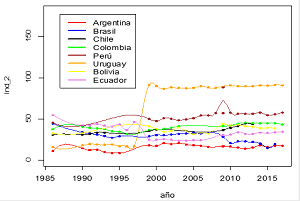LASSO model to compare indicators of social development and well-being in Peru and the South American region
DOI:
https://doi.org/10.56926/unaaaciencia.v2i2.29Keywords:
comparison, age group, gender indicators, social securityAbstract
Measuring poverty is a pending issue in South America. The objective was to describe, explain and compare the levels of social development and well-being of the citizens of Peru compared to South America. The research was non-experimental, quantitative method, explanatory, with longitudinal design; We use the LASSO and PLS regression model with data related to development and well-being indicators. We identify three indicators that differentiate the countries considered: Argentina, Brazil, Chile, Colombia, Peru and Uruguay; These reflect characteristics associated with gender, age groups, access to social security and employment status; we observe the presence of two seasonal cycles throughout the entire series, the first associated with the first two decades of study (1986-2000) and the second that begins in the year 2000 and shows a tendency towards stability. We show the presence of groups of countries in South America with similar characteristics related to gender, access to social security and employment status.
Downloads
References
Armando Mendoza, N. (2019). Brechas Latentes-índice de avance contra la desigualdad en el Perú 2017-2018 (1ta ed.). OXFAM.
BID. (2020). Números para el Desarrollo. Banco Interamericano de Desarrollo. https://code.iadb.org/es/herramientas/numeros-para-el-desarrollo
Bjorn-Helge, M., & Wehrens, R. (2016). Introduction to the pls Package. Cran R. https://cran.r-project.org/web/packages/pls/vignettes/pls-manual.pdf
CEPAL. (2021). Pandemia provoca aumento en los niveles de pobreza sin precedentes en las últimas décadas e impacta fuertemente en la desigualdad y el empleo. Organización de Las Naciones Unidas. https://www.cepal.org/es/comunicados/pandemia-provoca-aumento-niveles-pobreza-sin-precedentes-ultimas-decadas-impacta
Efron, B., Hastie, T., Johnstone, I., & Tibshirani, R. (2004). Least angle regression. The Annals of Statistics, 32(2). https://doi.org/10.1214/009053604000000067 DOI: https://doi.org/10.1214/009053604000000067
Fan, J., & Li, R. (2001). Variable Selection via Nonconcave Penalized Likelihood and its Oracle Properties. Journal of the American Statistical Association, 96(456), 1348–1360. https://doi.org/10.1198/016214501753382273 DOI: https://doi.org/10.1198/016214501753382273
Fan, J., & Li, R. (2006). Statistical Challenges with High Dimensionality: Feature Selection in Knowledge Discovery. Statistics Theory, 1(3). https://doi.org/https://doi.org/10.48550/arXiv.math/0602133
Fernández, L., & Gutiérrez, M. (2013). Bienestar Social, Económico y Ambiental para las Presentes y Futuras Generaciones. Información Tecnológica, 24(2), 121–130. https://doi.org/10.4067/S0718-07642013000200013 DOI: https://doi.org/10.4067/S0718-07642013000200013
Frank, I. E., & Friedman, J. H. (1993). A Statistical View of Some Chemometrics Regression Tools. Technometrics, 35(2), 109. https://doi.org/10.2307/1269656 DOI: https://doi.org/10.1080/00401706.1993.10485033
Friedman, J., Hastie, T., & Tibshirani, R. (2010). Regularization Paths for Generalized Linear Models via Coordinate Descent. Journal of Statistical Software, 33(1). https://doi.org/10.18637/jss.v033.i01 DOI: https://doi.org/10.18637/jss.v033.i01
Fu, W. J. (1998). Penalized Regressions: The Bridge versus the Lasso. Journal of Computational and Graphical Statistics, 7(3), 397. https://doi.org/10.2307/1390712 DOI: https://doi.org/10.2307/1390712
Hernández Sampieri, R., Fernández Collado, C., & Baptista Lucio, P. (2014). Metodología de la investigación (6ta ed.). McGraw-Hill Education.
INEI. (2021). Pobreza monetaria alcanzó al 30,1% de la población del país durante el año 2020. https://www.inei.gob.pe/prensa/noticias/pobreza-monetaria-alcanzo-al-301-de-la-poblacion-del-pais-durante-el-ano-2020-12875/
Londoño Vásquez, D. A., & Castañeda Naranjo, L. S. (2010). La comprensión como método en las ciencias sociales. Revista Virtual Universidad Católica Del Norte, 31. https://revistavirtual.ucn.edu.co/index.php/RevistaUCN/article/view/43
Mattei, L. (2017a). O debate sobre a reforma agrária no contexto do Brasil rural atual. Política & Sociedade, 15, 234. https://doi.org/10.5007/2175-7984.2016v15nesp1p234
Mattei, L. (2017b). O debate sobre a reforma agrária no contexto do Brasil rural atual. Política & Sociedade, 15, 234. https://doi.org/10.5007/2175-7984.2016v15nesp1p234 DOI: https://doi.org/10.5007/2175-7984.2016v15nesp1p234
Mevik, B.-H., & Wehrens, R. (2007). The pls Package: Principal Component and Partial Least Squares Regression in R. Journal of Statistical Software, 18(2). https://doi.org/10.18637/jss.v018.i02 DOI: https://doi.org/10.18637/jss.v018.i02
ONU. (2022). Objetivos del Desarrollo Sostenible. Organización de Las Naciones Unidas. https://www.un.org/sustainabledevelopment/es/
ONU DAES. (2022). World Population Prospects 2022. https://www.un.org/development/desa/pd/es/content/World-Population-Prospects-2022
R Core Team. (2021). R: A Language and Environment for Statistical Computing. R Foundation for Statistical Computing. https://www.r-project.org/
Sen, A. (1985). Resources, Values and Development. The Economic Journal, 95(379), 822. https://doi.org/10.2307/2233061 DOI: https://doi.org/10.2307/2233061
Tibshirani, R. (2011). Regression shrinkage and selection via the lasso: a retrospective. Journal of the Royal Statistical Society: Series B (Statistical Methodology), 73(3), 273–282. https://doi.org/10.1111/j.1467-9868.2011.00771.x DOI: https://doi.org/10.1111/j.1467-9868.2011.00771.x
UNESCO. (2019). Informe Mundial de las Naciones Unidas sobre el Desarrollo de los Recursos Hídricos 2019. https://www.acnur.org/5c93e4c34.pdf
Uribe Mallarino, C. (2004). Desarrollo social y bienestar. Universitas Humanística, 58(58). https://revistas.javeriana.edu.co/index.php/univhumanistica/article/view/9509

Published
How to Cite
Issue
Section
License
Copyright (c) 2023 Roberto Alejandro Pacheco-Robles, Santiago Vela-Del-Águila, Oscar Tuesta-Hidalgo, Juan Carlos Tuesta-Hidalgo, Marco Antonio Nureña-Hidalgo, Juan Manuel Vela-Lozano

This work is licensed under a Creative Commons Attribution 4.0 International License.
The authors retain their rights:
a. The authors retain their trademark and patent rights, as well as any process or procedure described in the article.
b. The authors retain the right to share, copy, distribute, execute and publicly communicate the article published in the scientific journal UNAAACIENCIA-PERÚ (for example, place it in an institutional repository or publish it in a book), with an acknowledgment of its initial publication in UNAAACIENCIA-PERU.
c. Authors retain the right to make a subsequent publication of their work, to use the article or any part of it (for example: a compilation of their works, notes for conferences, thesis, or for a book), provided that they indicate the source. of publication (authors of the work, magazine, volume, number and date).







